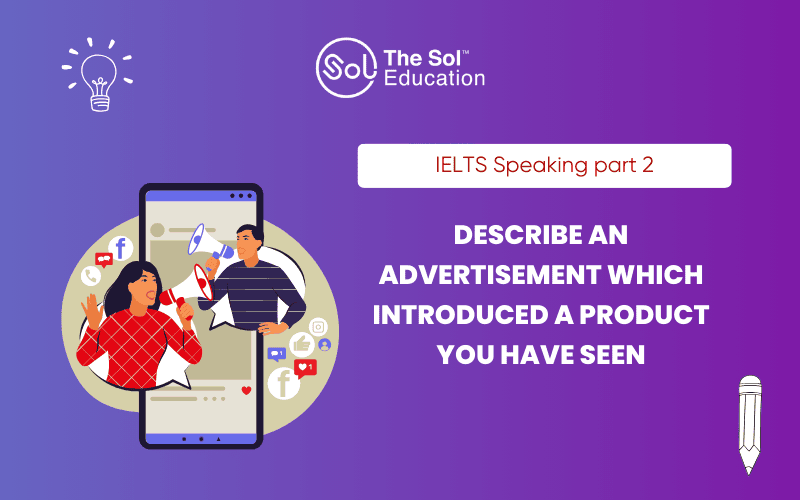Trong bài viết này, chúng ta hãy cùng SOL IELTS cùng phân tích và chữa chi tiết một đề IELTS Speaking Part 2 và Part 3, giúp các bạn hiểu cách xây dựng bài nói trôi chảy, tự nhiên và đạt điểm cao. Đề bài lần này liên quan đến chủ đề Advertisements – một chủ đề rất phổ biến trong IELTS Speaking.
Describe an advertisement which introduced a product you have seen.
You should say:
Với đề bài trên, chúng ta sẽ triển khai ý tưởng bằng cách trả lời các câu hỏi trong cue card:
When and where you saw the advertisement (Khi nào và ở đâu bạn thấy quảng cáo):
What the product was (Sản phẩm là gì):
How you liked the advertisement (Bạn thích quảng cáo này như thế nào):
How you felt about it (Bạn cảm thấy thế nào về quảng cáo):

Bài nói này phù hợp với thí sinh trình độ trung bình, đáp ứng các tiêu chí cơ bản của IELTS Speaking. Bài nói có cấu trúc rõ ràng, từ vựng đơn giản nhưng đúng ngữ cảnh, ngữ pháp cơ bản, và phát âm dễ hiểu. Chúng ta áp có thể sử dụng linking phrases đơn giản và một số collocations.
Sample Answer:
Well, I’d like to talk about an advertisement I saw recently. To start with, I saw this ad on TV last month while watching a music program. It was in the evening, maybe around 7 p.m., during a commercial break.
The advertisement was about a new type of instant coffee. It was a brand that makes coffee with different flavors, and this one was a low-sugar option. The ad showed a young person drinking coffee in a cozy café, which looked very relaxing.
Next, I liked the advertisement because it was short and clear. The music was pleasant, and the pictures of the coffee were attractive. It made me want to try a cup of coffee right away! But I think the ad was a bit too short, so I didn’t learn much about the product.
Lastly, I felt quite interested in the coffee after watching the ad. I enjoy drinking coffee, so I thought I might try this new flavor someday. It wasn’t a very exciting ad, but it did make me notice the product.
Danh sách từ vựng hữu ích:
cozy /ˈkəʊzi/: ấm cúng
commercial break /kəˈmɜːrʃl breɪk/: khoảng nghỉ quảng cáo
instant coffee /ˈɪnstənt ˈkɒfi/: cà phê hòa tan
flavor /ˈfleɪvər/: hương vị
relaxing /rɪˈlæksɪŋ/: thư giãn
Bài nói này phù hợp với thí sinh trình độ cao, sử dụng từ vựng phong phú, collocations tự nhiên, ngữ pháp đa dạng. Bài nói cần có cấu trúc bài nói rõ ràng, topic vocabulary, collocations, cấu trúc V-ing...
Sample Answer:
As someone who loves staying updated with new products, I’ve come across plenty of advertisements, but today I’d like to share one that really stood out. Let me kick off by talking about when and where I saw it. It was a couple of months ago while I was scrolling through my social media feed on my phone. The ad popped up, and I couldn’t resist watching it.
The advertisement was promoting a pair of wireless earphones with advanced noise-canceling technology. The brand was well-known for its tech gadgets, and they were marketing these earphones as perfect for music lovers and people working remotely.
Moving forward to what I liked about the ad, I’d say it was brilliantly executed. The visuals were strikingly vibrant, showing people using the earphones in different settings, like jogging, working, or chilling at home. The background music was upbeat and catchy, which gave the ad an energetic feel. Plus, the ad had a clever tagline: “Tune out the noise, tune in to your world,” which really stuck with me.
Lastly, I’m gonna explain how I felt about it. Watching the ad, I felt genuinely intrigued and tempted to explore the product further. The way it highlighted the earphones’ sleek design and practical features, like long battery life, made me think they’d be great for my daily routine. That said, I haven’t purchased them yet as I’m still comparing options, but the ad definitely left a lasting impression.
Danh sách từ vựng hữu ích:
wireless earphones /ˈwaɪələs ˈɪəfəʊnz/: tai nghe không dây
noise-canceling /ˈnɔɪz ˈkænsəlɪŋ/: chống ồn
strikingly vibrant /ˈstraɪkɪŋli ˈvaɪbrənt/: rực rỡ nổi bật
upbeat and catchy /ˈʌpbiːt ənd ˈkætʃi/: sôi động và dễ nhớ
sleek design /sliːk dɪˈzaɪn/: thiết kế tinh tế
lasting impression /ˈlæstɪŋ ɪmˈpreʃn/: ấn tượng lâu dài
I think advertisements are in many places. For example, on TV, we see ads during movies or shows. Also, on the internet, like on YouTube or social media, there are ads all the time. Sometimes, we see big advertisements on the street, like billboards near shopping areas or posters at bus stops. I think ads are very common nowadays.
Danh sách từ vựng hữu ích:
billboards /ˈbɪlbɔːrdz/: biển quảng cáo lớn
posters /ˈpəʊstərz/: áp phích
bus stops /ˈbʌs stɒps/: trạm xe buýt
As far as I’m concerned, advertisements are practically everywhere these days. To name one example, television is a major platform, with commercials airing during popular shows or sports events. On top of that, the internet is flooded with ads, from pop-up banners on websites to sponsored posts on social media apps like Instagram or TikTok. More specifically, in cities, you can’t miss eye-catching billboards or digital screens at shopping malls and public transport areas, like train stations or bus terminals.
Danh sách từ vựng hữu ích:
popular shows /ˈpɒpjələr ʃəʊz/: chương trình nổi tiếng
sponsored posts /ˈspɒnsərd pəʊsts/: bài đăng tài trợ
eye-catching billboards /ˈaɪ ˈkætʃɪŋ ˈbɪlbɔːrdz/: biển quảng cáo thu hút
public transport areas /ˈpʌblɪk ˈtrænspɔːrt ˈeəriəz/: khu vực giao thông công cộng
I think advertising has some benefits. First, it helps people learn about new products. For example, when a company makes a new phone, ads show us its features. Second, ads help businesses sell more, so they can grow. Also, some ads are fun to watch, so they make us feel good. I think ads are useful because they give us new ideas about what to buy.
Danh sách từ vựng hữu ích:
new products /njuː ˈprɒdʌkts/: sản phẩm mới
features /ˈfiːtʃərz/: tính năng
sell more /sel mɔːr/: bán được nhiều hơn
To my way of thinking, advertising offers several key advantages. For starters, it’s essential for raising awareness about new products or services. For example, ads for tech gadgets often highlight their unique features, drawing in curious customers. What’s more, advertising fuels business growth by boosting sales and encouraging competition, which ultimately benefits consumers with more choices. I’d go as far as to say that creative ads can also entertain and inspire, with some campaigns leaving a lasting impact. Seeing a well-made ad, I often feel motivated to explore new brands or try something different.
Danh sách từ vựng hữu ích:
raising awareness /ˈreɪzɪŋ əˈweənəs/: nâng cao nhận thức
unique features /juːˈniːk ˈfiːtʃərz/: tính năng độc đáo
fuels business growth /ˈfjuːəlz ˈbɪznəs ɡrəʊθ/: thúc đẩy tăng trưởng kinh doanh
lasting impact /ˈlæstɪŋ ˈɪmpækt/: tác động lâu dài
I think advertisements can be good and bad for children. On the good side, some ads show healthy food or educational toys, which are helpful. For example, ads for books or milk can teach kids good habits. But on the bad side, many ads are about junk food or expensive toys, so kids may want to buy them. I think parents should control what ads their kids see.
Danh sách từ vựng hữu ích:
healthy food /ˈhelθi fuːd/: thực phẩm lành mạnh
educational toys /ˌedʒuˈkeɪʃənl tɔɪz/: đồ chơi giáo dục
junk food /dʒʌŋk fuːd/: đồ ăn vặt
The way I see it, advertisements can have both positive and negative effects on children, depending on their content. To share one example, ads promoting nutritious products, like fruit snacks or learning apps, can encourage healthy habits or spark curiosity. That said, many ads, especially those for sugary snacks or trendy toys, can manipulate young minds, triggering unhealthy cravings or materialistic desires. Mind you, children often lack the critical thinking to separate persuasive marketing from actual needs, making them vulnerable to such influences. Monitoring what kids are exposed to, I believe, is crucial for parents.
Danh sách từ vựng hữu ích:
nutritious products /njuːˈtrɪʃəs ˈprɒdʌkts/: sản phẩm giàu dinh dưỡng
sugary snacks /ˈʃʊɡəri snæks/: đồ ăn vặt chứa đường
manipulate young minds /məˈnɪpjuleɪt jʌŋ maɪndz/: thao túng tâm trí trẻ
critical thinking /ˈkrɪtɪkl ˈθɪŋkɪŋ/: tư duy phản biện
I think advertising affects people a lot. First, it makes people want to buy new things. For example, ads for clothes or gadgets make us feel we need them. Second, ads can change how we think, like ads for beauty products make us want to look better. But sometimes, ads are bad because they make us spend too much money. I think ads are powerful.
Danh sách từ vựng hữu ích:
beauty products /ˈbjuːti ˈprɒdʌkts/: sản phẩm làm đẹp
spend money /spend ˈmʌni/: tiêu tiền
feel like /fiːl laɪk/: cảm thấy muốn
What I reckon is that advertising significantly shapes people’s behaviors and perceptions. To kick off, it’s highly effective at driving consumer behavior, prompting purchases by showcasing product benefits or creating a sense of urgency. For instance, ads for smartphones often emphasize cutting-edge features, making people feel they need an upgrade. More importantly, advertising can influence societal trends, such as beauty ideals, with campaigns for cosmetics promoting images that impact self-esteem, especially among younger audiences. With that being said, constant exposure to ads can lead to impulsive buying, as persuasive marketing often tempts people to splurge. Encountering catchy ads daily, I sometimes find it hard to resist the urge to shop.
Danh sách từ vựng hữu ích:
driving consumer behavior /ˈdraɪvɪŋ kənˈsjuːmər bɪˈheɪvjər/: thúc đẩy hành vi người tiêu dùng
cutting-edge features /ˌkʌtɪŋ ˈedʒ ˈfiːtʃərz/: tính năng tiên phong
impulsive buying /ɪmˈpʌlsɪv ˈbaɪɪŋ/: mua sắm bốc đồng
societal trends /səˈsaɪətl trendz/: xu hướng xã hội
Hy vọng bài chữa đề này đã giúp các bạn hiểu cách xây dựng bài nói IELTS Speaking Part 2 và Part 3 một cách hiệu quả! Đừng quên luyện tập phát âm, đặc biệt là âm cuối (/s/, /z/), và chuẩn bị ý tưởng theo phương pháp “Topic-ise your life” để mở rộng vốn từ. Chúc các bạn tự học IELTS thành công và sớm đạt band điểm mong muốn nhé.
